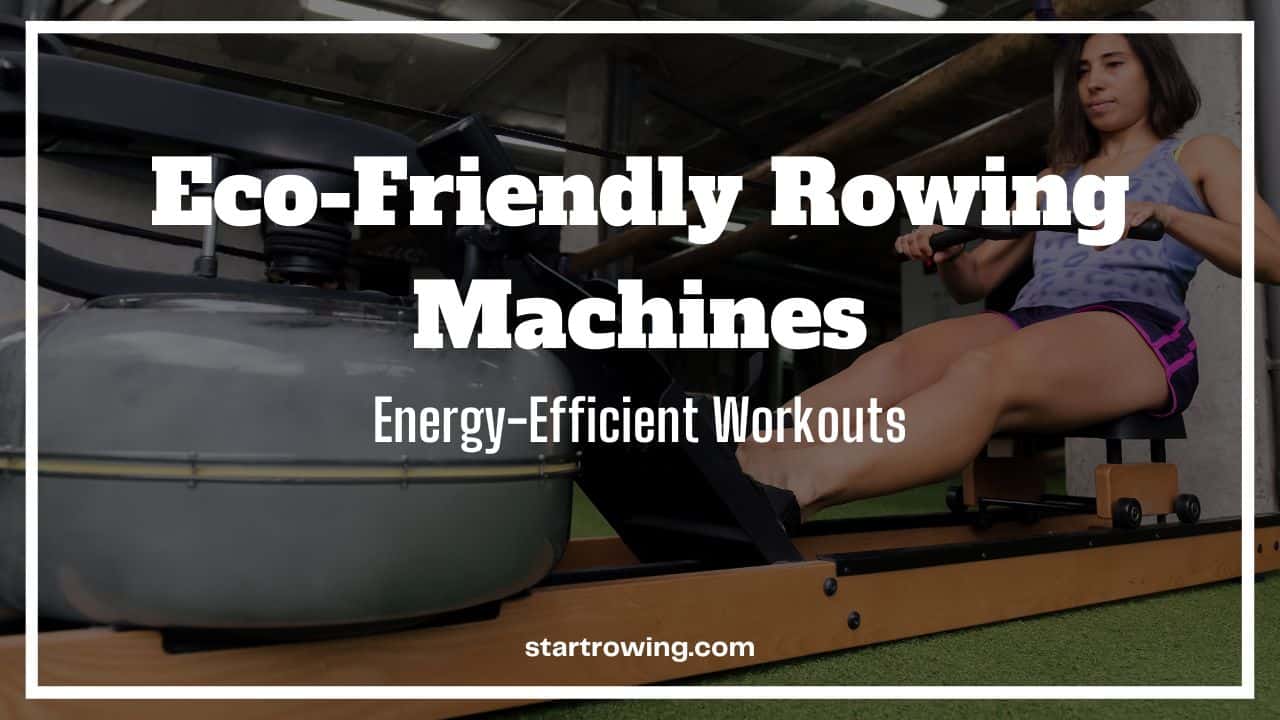Imagine getting an intense, full-body workout that not only keeps you fit but also reduces your environmental impact. Using particular water and air rowers can help achieve this goal.
In this article, I’ll guide you through the ins and outs of these eco-friendly rowing machines, so you can make an informed decision and join the growing movement of sustainable fitness enthusiasts.
Read on to learn how water and air rowers can transform your exercise routine and contribute to a healthier planet for all!
Table of Contents
Water Rowers: Harnessing the Power of Fluid Resistance
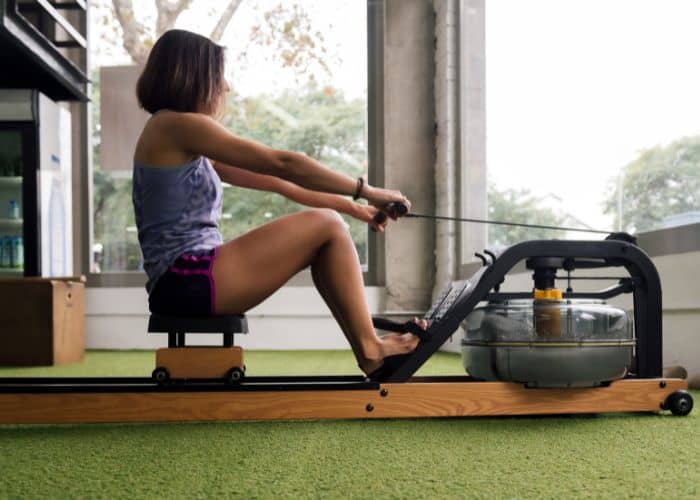
Water rowers offer an incredibly unique and eco-friendly rowing experience. By harnessing the power of water resistance, these machines provide a natural and efficient workout that helps protect the environment while delivering an effective exercise routine.
In this section, we’ll dive into the inner workings of water rowers, their energy efficiency, and their use of sustainable materials.
How Water Rowers Work
Water rowers consist of two main components:
Water Flywheel
The water flywheel is an enclosed, water-filled tank located at the front of the rower. As you pull the handle, a paddle inside the tank rotates, causing the water to move and creating resistance.
The resistance is directly proportional to the speed of your rowing, which means the harder you row, the more resistance you’ll experience. Good water rowers have the ability to provide a realistic rowing feel that closely simulates on-water rowing.
Resistance Generated by Water Displacement
As mentioned earlier, the resistance in water rowers is created by the movement of water inside the flywheel. This type of resistance is unique because it is self-regulating – the faster you row, the more water is displaced, and the greater the resistance becomes. This allows you to control the intensity of your workout by simply adjusting your rowing speed.
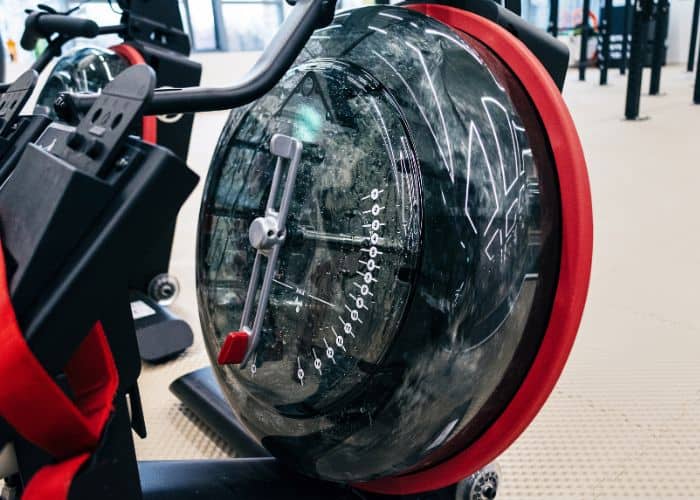
Energy Efficiency of Water Rowers
Water rowers are an excellent choice for eco-friendly fitness enthusiasts due to their energy efficiency:
No Electricity is Required for Resistance
Unlike some other types of rowing machines, water rowers do not require electricity to generate resistance.
This means that you can achieve an effective, full-body workout without consuming any electricity, reducing your carbon footprint and lowering your energy bills.
Minimal Energy Usage for Monitors (Battery-powered or Self-generating)
The majority of water rowers come equipped with battery-powered or self-generating monitors that display important workout information such as distance, time, and calories burned.
These monitors typically consume minimal energy, further contributing to the energy efficiency of water rowers.
Additional Eco-Friendly Benefits
Water rowers offer several other eco-friendly advantages that make them an appealing choice for those looking to minimize their environmental impact:
Natural and Smooth Rowing Motion
The fluid resistance provided by water rowers creates a natural, smooth rowing motion that is gentle on the joints and promotes proper rowing technique. This not only makes for a more enjoyable workout experience but can also help reduce the risk of injury.
Potential use of Sustainable Materials (e.g., wood frames)
One of the additional eco-friendly benefits of water rowers is their potential for using sustainable materials in their construction.
Many high-quality water rowing machines are built with wooden frames sourced from sustainably managed forests. These wood frames not only provide a visually appealing and natural look but also help reduce the overall environmental impact of the rower.
By choosing a water rower with a wooden frame, you are supporting responsible forestry practices and contributing to a more sustainable fitness solution.
Air Rowers: Capitalizing on Air Resistance for a Greener Workout
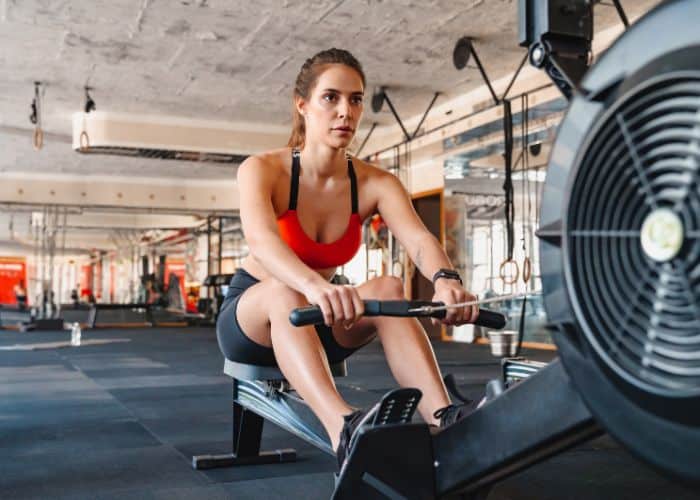
Air rowers offer another environmentally friendly option for those looking to prioritize eco-friendly fitness. By leveraging the power of air resistance, these rowing machines deliver a challenging workout without a significant environmental impact.
In this section, we’ll explore how air rowers work, their energy efficiency, and the additional benefits they bring to the table in terms of sustainability.
How Air Rowers Work
Air rowing machines utilize an air flywheel to generate resistance. As the user pulls the handle, the flywheel spins, and the air inside the machine is displaced, creating resistance that varies based on the user’s pulling speed.
Air Flywheel
The air flywheel is the central component of an air rower. It is designed to create a dynamic and responsive rowing experience, allowing users to easily adjust the resistance level by changing their rowing speed. The faster you row, the greater the resistance, and vice versa.
Resistance Generated by Air Displacement
Unlike water rowers that rely on water displacement, air rowers create resistance by displacing air within the machine. This offers a smooth and consistent resistance that can be easily adjusted by the user, making it an excellent choice for athletes looking to fine-tune their workouts.
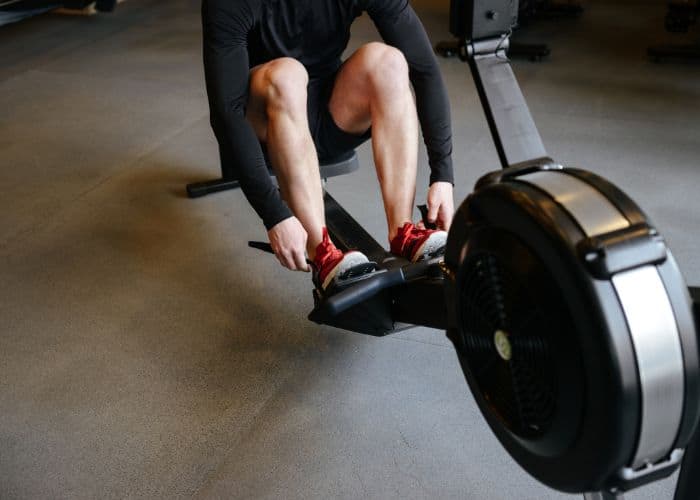
Energy Efficiency of Air Rowers
Air rowers are also highly energy-efficient machines, as they do not require electricity to generate resistance.
No Electricity Required for Resistance
Just like water rowers, air rowers use natural resistance mechanisms to provide an effective workout. By eliminating the need for electricity to generate resistance, air rowers significantly reduce their overall energy consumption.
Minimal Energy Usage for Monitors (battery-powered or self-generating)
The monitoring systems on air rowers typically consume minimal energy. Many air rowers come equipped with battery-powered or self-generating monitors that track workout data, further reducing the environmental impact of these machines.
Additional Eco-Friendly Benefits
Air rowers offer several other benefits that contribute to their eco-friendly nature.
Easily Adjustable Resistance
One of the key advantages of air rowers is their easily adjustable resistance. By simply changing their rowing speed, users can quickly and efficiently adjust the intensity of their workout without relying on energy-consuming mechanical adjustments.
Durable Construction for Long-Lasting Use
Air rowers are often built with sturdy materials and durable construction, ensuring that they can withstand years of use. By investing in a high-quality air rower, you can extend the life of your fitness equipment, reduce waste, and contribute to a greener workout routine.
Comparing Water and Air Rowers for Energy Efficiency
When it comes to energy efficiency, both water and air rowers offer eco-friendly alternatives to traditional fitness equipment.
While each type of rower has its unique features and benefits, they both utilize natural resistance mechanisms and minimize energy consumption.
Similarities in Energy Efficiency
Both rely on natural resistance mechanisms: Water and air rowers both use natural elements (water and air, respectively) to generate resistance. This eliminates the need for electricity to power resistance mechanisms, significantly reducing energy consumption.
Low energy consumption for monitoring systems: The monitoring systems on both water and air rowers typically consume minimal energy. Many models come with battery-powered or self-generating monitors, further minimizing their environmental impact. Obviously, this does not include interactive rowers that have screens or need to be plugged in.
Differences in Energy Efficiency
While both types of rowers are energy-efficient, there are some differences between water and air rowers that may influence your decision.
Noise levels (water rowers tend to be quieter): Water rowers are generally known for their quieter operation compared to air rowers. The sound of water in the tank offers a soothing and natural ambiance, which can be a significant advantage for users who prefer a quieter workout environment. In contrast, air rowers produce more noise due to the movement of air within the machine, which may not be suitable for all users.
Maintenance requirements (water rowers may require periodic water treatment): Water rowers may require slightly more maintenance than air rowers, as they need periodic water treatment to prevent algae growth and maintain optimal performance. However, this maintenance is relatively easy to perform and should not be a major deterrent for those considering a water rower. Air rowers, on the other hand, require minimal maintenance, mostly involving cleaning and occasional lubrication of moving parts.
Ultimately, both water and air rowers are great choices for eco-friendly-conscious consumers.
Choosing the Right Rower for Your Eco-Friendly Fitness Goals
With both water and air rowers offering energy-efficient options for eco-friendly fitness, it’s important to choose the right machine to suit your individual needs and preferences.
In this section, we’ll discuss some key considerations for selecting the perfect rower to meet your eco-friendly fitness goals.
Considerations for Selecting a Rower
Personal preferences (rowing feel, noise levels, maintenance): Take into account your personal preferences when selecting a rower. Consider the feel of the rowing motion, the noise levels produced by the machine, and the maintenance requirements. Water rowers offer a more natural rowing motion and a quieter workout experience, while air rowers provide easily adjustable resistance and lower maintenance needs.
Space requirements: Assess the space available in your home or gym for a rowing machine. Water rowers tend to have a larger footprint due to the water tank, while air rowers can be more compact. Some rowing machines are designed to be easily stored when not in use, either by folding or standing upright, which can be a significant advantage if space is limited.
Budget constraints: Rowing machines can vary greatly in price, so consider your budget when making a decision. While investing in a high-quality and durable rower is essential for long-lasting use and optimal performance, there are affordable options available that still offer energy efficiency and eco-friendly features.
The Importance of Investing in A Durable and High-Quality Rower
Longevity and reduced waste: Investing in a durable and high-quality rower is essential for reducing waste and contributing to a greener workout routine. A well-built rower can last for many years, minimizing the need for frequent replacements and reducing the overall environmental impact of your fitness equipment.
Optimal performance for a more effective workout: A high-quality rower will provide a smoother, more efficient workout experience, allowing you to get the most out of your exercise routine. By investing in a premium rowing machine, you can enjoy a more effective workout while minimizing your environmental footprint.
Additional Tips for Eco-Friendly Fitness with Rowing Machines
In addition to choosing the right energy-efficient rower, there are other ways you can incorporate eco-friendly habits into your fitness routine.
By adopting these practices, you can further minimize your environmental impact and contribute to a greener and healthier lifestyle.
Here are some additional tips for maximizing the eco-friendliness of your rowing machine workouts:
Incorporate Energy-Saving Habits into Your Workout Routine
Unplug electronics when not in use: To conserve energy, make sure to unplug your rowing machine and any other electronic devices when they’re not in use. This helps prevent energy waste from standby power consumption, also known as “phantom load.”
Use natural lighting for daytime workouts: Instead of relying on artificial lighting, try to schedule your workouts during daylight hours and take advantage of natural sunlight. This will not only save energy but also provide a more pleasant and uplifting workout environment.
Regular Maintenance for Optimal Performance and Longevity
Clean and lubricate moving parts as needed: Properly maintaining your rowing machine ensures its optimal performance and extends its lifespan. Regularly clean and lubricate any moving parts, such as the seat rail, chain, or flywheel, to prevent wear and tear and maintain a smooth rowing experience.
Check and replace worn parts as necessary: Inspect your rowing machine periodically for any worn or damaged parts, and replace them as needed. This will help prevent potential injuries and ensure that your machine continues to operate efficiently and sustainably.
Properly Recycle or Dispose of Old Equipment and Batteries
Contact local recycling centers or manufacturers for guidance: If you need to dispose of an old rowing machine or replace batteries from the monitoring system, be sure to do so responsibly.
Contact your local recycling center or the rower manufacturer for guidance on proper disposal methods.
Donate functional equipment to community centers or charities: Instead of discarding functional rowing machines, consider donating them to community centers, schools, or charities.
This not only extends the life of the equipment but also provides others with access to eco-friendly fitness options.
Educate Others About the Benefits of Eco-Friendly Fitness
Share your experiences with friends and family: Encourage others to embrace eco-friendly fitness by sharing your experiences with water or air rowers. Discuss the benefits of these machines, as well as the importance of sustainable exercise habits.
Promote sustainable fitness practices on social media or in your community: Use your online presence or community connections to advocate for eco-friendly fitness practices. Share tips, insights, and information on sustainable exercise habits, and inspire others to make environmentally responsible choices for their fitness routines.
Before You Go…
As we strive to make more eco-friendly choices in our daily lives, it’s essential to remember that our fitness routines can also have a significant impact on the environment. When choosing fitness equipment, consider the environmental impact of the machines and opt for energy-efficient options like water or air rowers.
Rowing machines have the potential to contribute to a more sustainable and eco-friendly fitness routine, minimizing energy consumption and reducing waste. By investing in a high-quality rower and adopting sustainable exercise habits, you can enjoy a challenging workout while doing your part to protect our planet.
Now is the time to take action and make a conscious effort to choose environmentally responsible fitness equipment. Embrace the challenge of eco-friendly fitness, share your experiences with others, and encourage them to make greener choices in their own exercise routines. Together, we can create a healthier and more sustainable world for ourselves and future generations.

